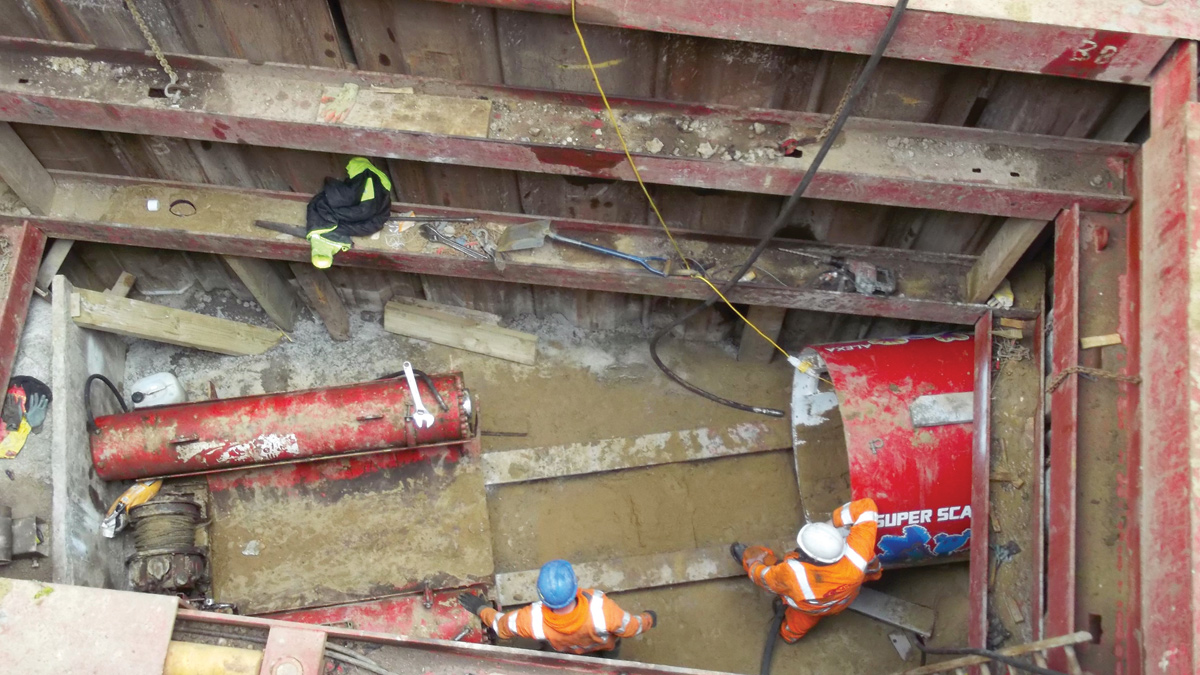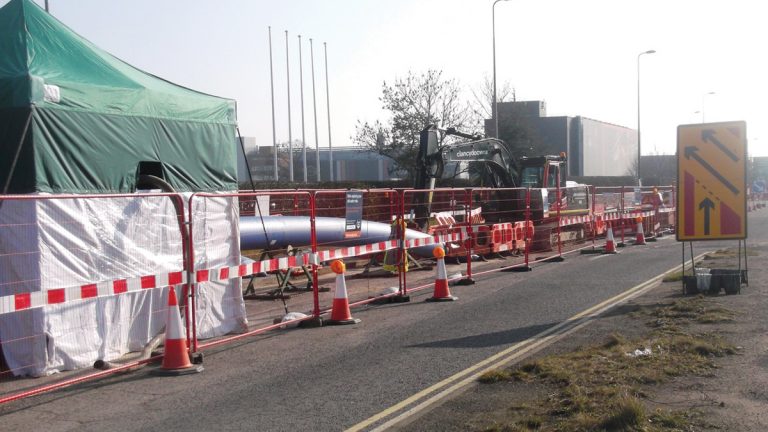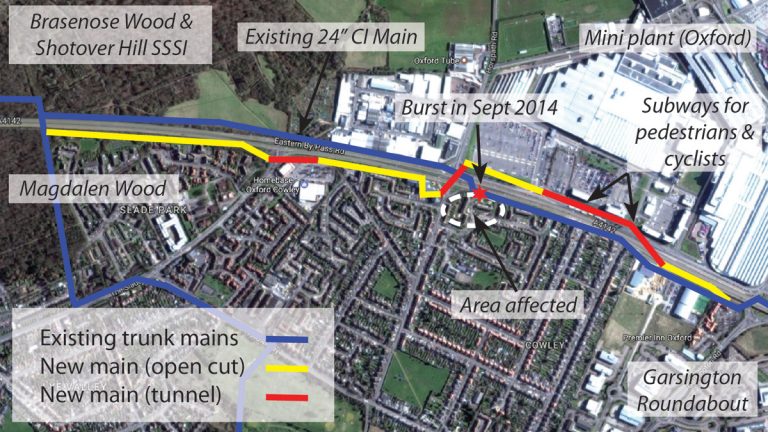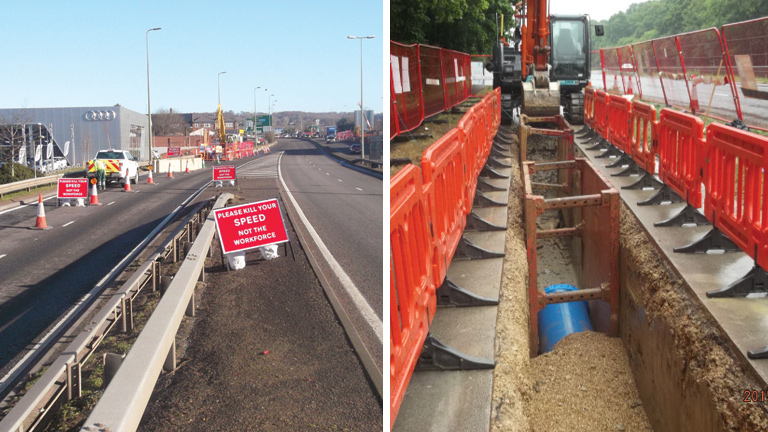Cowley Trunk Main Project (2017)

Pipe jacking pit - Courtesy of Optimise
Following a burst on the existing 24” trunk main running along the Oxford Eastern Bypass in September 2014 causing severe flooding, Thames Water made the decision to replace the high risk section of the main to prevent future pipe failures. The Optimise Joint Venture delivered the £6m project, installing 2km of replacement trunk main along the busy dual carriageway, whilst minimising disruption to local traffic and effectively engaging with third parties and the local community.
Background
On 23 September 2014, a burst occurred on the existing 24” cast iron trunk main running along the Oxford Eastern Bypass, which caused severe flooding to properties in the adjoining residential area. The main also had previously burst along the same stretch of the road in 2007. In order to reduce the risk of the pipe bursting again and the potential major impact of any further events, Thames Water made the decision to replace the section where the main is closest to residential and commercial properties.
In January 2015, Optimise was contracted to replace a 2km section of the trunk main that runs between Magdalen Wood to the north and Garsington roundabout to the south. Optimise is a joint venture made up of Barhale, Clancy Docwra, Murphy and MWH (now Stantec UK) to deliver TWUL’s Asset Management Plan 5 (AMP5) capital works programme.
Project site
The site is located along the A4142 Oxford Eastern Bypass Road in Cowley, approximately 3km east of the centre of the City of Oxford. The road is a busy dual carriageway, which forms the south eastern section of the Oxford ring road. One section of the road where work was carried out is bounded by MINI Plant Oxford, which is the central assembly facility for the MINI range of cars.
Along the pipeline route, there are 2 subways crossing under the road (one for pedestrians and one for cyclists), which needed to be negotiated by the new main. On the northern section of the pipeline route, the Brasenose Wood and Shotover Hill Site of Special Scientific Interest (SSSI) is located adjacent to the eastern side of the road and Open Magdalen ancient woodland adjacent to the western side of the road.
The route of the pipeline is underlain by various strata and the ground at tunnelling depths was predominantly a firm sand with seams of limestone and sandstone running through it, which posed challenges to the tunnelling works carried out under this project.

Welding and insertion of PE liner into sleeve pipes from tunnel jacking pit – Courtesy of Optimise
Pipeline route and installation methods
With regards to the pipeline rehabilitation and replacement options, sliplining and on-line replacement options were immediately discounted as the existing 24” trunk main was vital for the water supply to the City of Oxford and surrounding areas and it could not be isolated for the works.
From the beginning of the project design, the Optimise design and construction teams collaboratively investigated the route of the new replacement trunk main and installation methods, taking into account the need to:
- Minimise disruption to traffic along the Eastern Bypass and connecting roads.
- Avoid working on and adjacent to the existing fragile 24” trunk main.
- Route the pipeline away from the area affected by the previous main bursts.
- Minimise disruptions to vehicles entering and exiting the MINI Oxford plant.
- Route the pipeline away from existing high risk underground services.
- Avoid working within environmentally sensitive areas.
The selected pipeline route and installation methods for the pipeline sections is shown in the figure below. The new main was generally routed on the opposite side of the road from the existing main. In terms of the pipe installation methods, open-trenching was planned in the carriageway and foot/cycle paths where possible, and the trenchless method was adopted where the new main crosses the roads and pedestrian and cycle subways.

Site plan – Courtesy of Optimise
Site investigations and design
As a part of the engineering investigation, a total of 16 boreholes were sunk along the proposed pipeline route, mostly along the tunnelling sections, in order to ascertain the nature of the underlying strata and assess the feasibility of the tunnelling work. A soil electrical resistivity survey was also carried out to determine the level of protection required against ground corrosivity for new metallic pipes.
In terms of the pipe material selection, the use of 600mm ID ductile iron pipes was selected for open-cut sections for ease of installation, due to the limited working space. For the trenchless sections, 630mm OD SDR 17 PE pipes were chosen to be installed within 1200mm ID PCC jacking pipes. Hydraulic modelling work carried out during the design stage confirmed that the selected pipes would have no effect on the transfer capacity of the trunk main and pressures in the supply zones.
In addition, in order to reduce the risk of future pipe failures and the consequent impact on the surrounding area, the installation of a Syrinix TrunkMinder leak and burst monitoring system was requested by Thames Water.
The proposal of installing a section of the new main in the road next to the MINI plant raised concerns for the BMW Group which operates the Mini Oxford plant. They were concerned that a possible future pipe leak or burst would affect the operation of their plant and business and requested the project team carry out detailed assessment on future pipe failure risks. Subsequently, a cross-functional team of engineers within Optimise, including civil engineers, a pipeline expert and a mechanical engineer, carried out a Failure Modes and Effects Analysis (FMEA), in order to identify possible failure modes of the new main and to assess the probability and consequence of each failure mode. The quantitatively presented results indicated that the choice of pipe materials, the pipeline design and the proposed construction methods would significantly reduce the risk of future pipe failure, compared to the risks associated with older mains. The assessment results were shared with the BMW Group who accepted the installation of the main on their side of the road, and the construction work could proceed.

(left) Pipeline construction along Oxford Eastern Bypass Road and (right) open trenching – Courtesy of Optimise
Due to the reactive and emergency nature of the project, a fast track design was carried out to enable the pipeline construction to commence from June 2015. The outline of the project scope included:
- Installation of DN600 DI pipes along the open-cut sections with line valves and other pipeline ancillaries (1560m in length).
- Installation of 630OD SDR17 PE liner within 1200mm PCC jacking pipes (470m in length), along with construction of 9 (No.) tunnelling launch and reception shafts (depths up to 9m).
- Connections to the existing distribution and trunk mains at 6 locations along the route.
- Installation of Syrinix Trunk Minder units at four locations, along with 1 (No.) ultrasonic flow meter chamber.
Environment and ecology
In the design stage, the design team carried out environmental surveys, including ecology surveys and a contaminated land assessment. The northern end of the existing 24” main ran through Brasenose Wood and Shotover Hill SSSI, however the new pipeline avoided the SSSI. This provided a permanent positive impact on the SSSI, as the need for any future maintenance works in the SSSI was removed. Some works were required to decommission the existing main within the SSSI – the impact of these works were assessed and assent was obtained from Natural England.
Construction
The construction work started in June 2015 from the northern end of the new pipeline, which mainly consisted of open-trench sections. Following the completion of the open-cut pipe installation, the tunnelling work began. For the tunnelling work, 6 (No.) tunnelling sections were completed, using a 1200mm diameter full faced TBM, although the TBM needed to be replaced with an open face shield to allow manual excavation along 2 (No.) tunnel sections where hard rock impeded the use of the TBM.
The construction team carried out the works whilst closely coordinating with the Oxfordshire County Council Highways Team and MINI plant to ensure that disruptions to the traffic along Eastern Bypass Road and deliveries to MINI plant were minimised. The Council Highways Team permitted a reduction of the speed limit to 30mph on the relevant stretch of the Eastern Bypass and closures of sections of the foot and cycle paths. These helped to create safe working conditions for the work force.
Throughout the project period, Thames Water set up a pipeline monitoring programme for the existing 24” main and carried out leak detection surveys along the previous burst pipeline section at regular intervals until the new water main was commissioned, to ensure that flooded properties didn’t experience flooding again during the construction period.
The construction of the new pipeline was successfully completed and the new main was commissioned in February 2017, along with the new trunk main monitoring system. Following this, the old 24” main was decommissioned, which removed the risk of pipe failure and flooding to the local area.

(left) Visit from local school with tunnel boring machine and (right) a school pupil and his mum inside the tunnel boring machine with TBM Driver – Courtesy of Optimise
Community engagement
Engagement with the local community was a key element of this project. A community drop-in session was organised by Thames Water and Optimise prior to commencement of the construction work, to inform residents of the local community of the proposed work and to discuss any project related issues. Regular letters, texts and a project webpage were set up to help keep local residents and users of the footpath and cyclepaths informed. A local school also took part in a competition organised by Optimise, to name the tunnel boring machines and design artwork to decorate them with to encourage young people to think about STEM (Science, Technology, Engineer and Mathematics).




